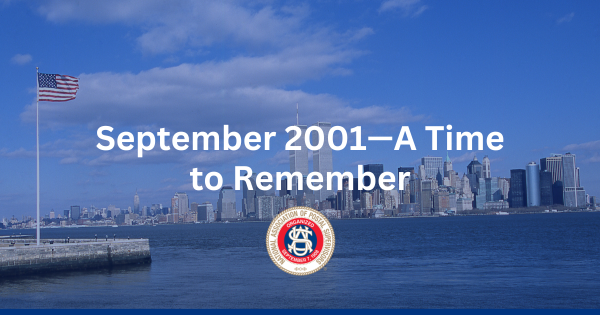September 2001—A Time to Remember
September 2001—A Time to Remember
By Chuck Mulidore
NAPS Executive Vice President
September is a busy time for families preparing for school getting back in session. Also, the bright, hot days of summer are fading into fall and baseball season is winding down in preparation for the World Series. And for EAS employees, fall mailing season is upon us.
However, September also is a time for reflection. Those of us who were working in September 2001 never will forget the tragedies that reshaped a nation and reinvented the Postal Service.
In fall 2001, the United States Postal Service, an institution as old as the nation itself, faced two historic challenges that would redefine its operations, safety protocols and role in American life. First came the devastating terrorist atacks on Sept. 11. Just one week later, letters laced with anthrax spores began arriving at newsrooms and congressional offices, turning mail into a weapon and making postal employees frontline casualties in a new kind of war.
When commercial air traffic was grounded nationwide in the aftermath of 9/11, mail delivery was immediately affected. The USPS relied heavily on commercial airlines to transport First Class and Priority Mail. With the skies closed, mail backed up and alternative transport methods had to be activated almost overnight.
Still, amidst the disruption, plants continued processing mail, carriers delivered on their routes and EAS employees stood on the front lines directing operations as a shocked and grieving nation sought a return to normalcy. In communities large and small, the daily visit of letter carriers became a reassuring sign of continuity in a moment when nothing felt normal. The familiar sight of a postal uniform took on renewed meaning—representing not just mail delivery, but the resilience of our country and the U.S. Postal Service.
On Sept. 18, 2001, the threat to the mail became deadly. Envelopes containing anthrax spores were sent to media offices and two U.S. senators. The attack killed five people and infected at least 22, including postal employees who processed the contaminated letters.
Among the lives lost were Joseph Curseen and Thomas Morris Jr., dedicated postal workers at the Brentwood Postal Facility in Washington, DC. Their deaths exposed the harsh reality that the nation’s postal system was being weaponized and its employees were paying the price.
Postal facilities were shut down for decontamination, thousands of employees feared for their safety as testing and treatment protocols were rapidly developed. Across the country, the once-routine act of opening mail was now approached with anxiety.
In response, the USPS launched one of the most significant overhauls of mail safety in its history. Biohazard detection systems were installed at major processing centers, some mail was irradiated to neutralize potential threats, postal employees received new safety training and personal protective equipment became standard under certain conditions.
The crisis also led to stronger partnerships with agencies such as the Centers for Disease Control and Prevention (CDC) and the Department of Homeland Security. The USPS formed a Mail Security Task Force to coordinate efforts and ensure that mail could remain dependable and safe.
Those weeks in September 2001 are forever etched in my memory as I am sure they are among all of those who went to work each day during that time. It is important that we never forget the events of September 2001 and pass that history on to new generations of employees. It is a testament to the nature of postal employees who seek to steady a nation in times of tragedy.
More than two decades later, the legacy of those two crises endures. Airline travel has never been the same as safety protocols remain in place to this very day. Those twin attacks accelerated USPS modernization, prompted lasting investments in screening and scanning technologies and reshaped employee health and safety protocols.
Perhaps most profoundly, those events underscored the essential role of postal employees as public servants—individuals who continued to show up even when their own safety was in question—a foundation of service that continued as the country faced down the threat of COVID-19 two decades later.
The USPS emerged from that September in 2001 not just as a carrier of the nation’s mail, but as a national lifeline—proving once again that, even in moments of fear, disruption, uncertainty and crisis, the mail must go through, with the devoted EAS employees of the U.S. Postal Service standing proudly in front, leading the way.
